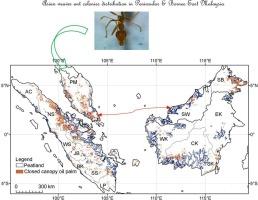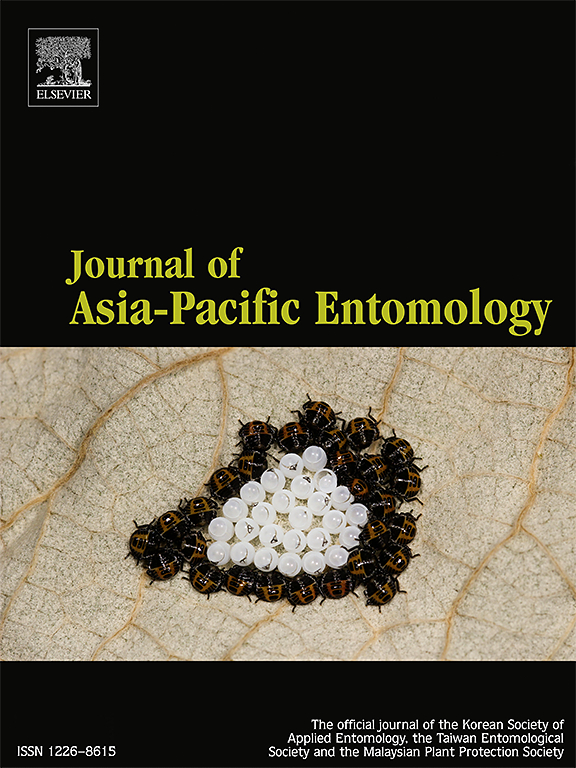东南亚油棕人工林中黄油棕(膜翅目:蚁科)蚁群分布及巢占模式
IF 1.3
3区 农林科学
Q3 ENTOMOLOGY
引用次数: 0
摘要
亚洲织蚁(Oecophylla smaragdina F.)是影响东南亚重要经济作物的主要害虫的有效天然捕食者。本研究对其在油棕种植园的空间分布进行了大规模评估(200,000公顷调查)。记录地理坐标和种群水平数据,以调查空间结构、占领模式、筑巢行为和类型学。采用判别分析(DA)对26个样本进行了功能巢类型(育雏型和营房型)的分析。棕榈树冠内的垂直位置成为一个可靠的视觉指标(巢的形态和内部内容被证明是不够的)。育雏巢平均高度为8.0±1.3 m(营房±4.0 m)。群落表现为多妻制结构,形成不规则的、相互连接的空间斑块,在较短的手掌中首次观察到单妻制。拮抗物种齿齿牙虫被认为是潜在的干扰媒介。利用负二项分布和泊松分布对巢穴和被占领棕榈树的数量估计的种群年龄进行建模。成熟的蚁群在800-2500 m2的面积内占据了10-12个棕榈,由一致的无蚁缓冲区(~ 20 m2)隔开。殖民化过程逐渐进行,平均每年占据3-4个棕榈,在3-4年内达到成熟。基于筑巢参数的泊松模型预测估计群体年龄显示出很强的相关性。在油棕地广泛而稳定的存在强调了该物种作为一种可持续的生物防治剂的潜力,以对抗入侵的袋虫(鳞翅目:心理科),这是油棕产量的主要威胁。本文章由计算机程序翻译,如有差异,请以英文原文为准。

Distribution and nest occupancy patterns of Oecophylla smaragdina (hymenoptera: formicidae) colonies in Southeast Asian oil palm plantations
The Asian weaver ant (Oecophylla smaragdina F.) is an effective natural predator of key pests affecting economically important crops across Southeast Asia. This study presents a large-scale assessment of its spatial distribution in oil palm plantations (200,000 ha surveys). Geographic coordinates and colony-level data were recorded to investigate spatial structure, the occupation pattern, nesting behaviour, and typology. To distinguish functional nest types (brood versus barracks), 26 samples were analysed using discriminant analysis (DA). The vertical positioning within the palm canopy emerged as a reliable visual indicator (nest morphology, internal content proved insufficient). Brood nests were located at heights averaging 8.0 ± 1.3 m (barracks ± 4.0 m). Colonies exhibited polydomous structure, forming irregular, interconnected spatial patches, with the first documented cases of monodomy observed in shorter palms. The antagonist ant species Odontoponera denticulata is suggested as a potential disruptor vector. Colony age, estimated from the number of nests and occupied palms, was modelled using negative binomial and Poisson distribution. Mature colonies occupied 10–12 palms within an area of 800–2500 m2, separated by consistent ant-free buffer zones (∼20 m2). Colonisation progressed gradually, with colonies occupying an average of 3–4 palms per year, reaching maturity within 3–4 years. Poisson modelling predictive estimation of colony age based on nesting parameters shows a strong correlation. O. smaragdina colonies’ widespread, stable presence throughout oil palm landscapes underscores the species’ potential as a sustainable biological control agent against the invasive bagworm Metisa plana Walker (Lepidoptera: Psychidae), a major threat to oil palm yields.
求助全文
通过发布文献求助,成功后即可免费获取论文全文。
去求助
来源期刊

Journal of Asia-pacific Entomology
Agricultural and Biological Sciences-Insect Science
CiteScore
2.70
自引率
6.70%
发文量
152
审稿时长
69 days
期刊介绍:
The journal publishes original research papers, review articles and short communications in the basic and applied area concerning insects, mites or other arthropods and nematodes of economic importance in agriculture, forestry, industry, human and animal health, and natural resource and environment management, and is the official journal of the Korean Society of Applied Entomology and the Taiwan Entomological Society.
 求助内容:
求助内容: 应助结果提醒方式:
应助结果提醒方式:


